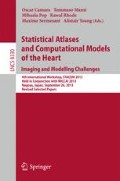Abstract
Objective: To develop an accurate and mathematically unambiguous method for interpolation of tensor orientation, specifically for the interpolation of cardiac microstructural orientation. Methods: A dyadic tensor-based (DY) orientation interpolation method, which sidesteps the eigenvector sign ambiguity problem by interpolating between the dyadic tensors of eigenvectors, is proposed and evaluated. The quaternion-based (QT) orientation interpolation method, which interpolates along the minimum rotation path between tensor orientations, is also revised and evaluated. DY and QT are compared to conventional tensor-based interpolation methods using both synthetic and cardiac DT-MRI data. Results: All methods (except QT) perform similarly well for recovery of the primary eigenvector. DY has significantly less bias than all other methods for recovery of the secondary and tertiary eigenvector, which is especially important for interpolating myolaminar sheet orientation. Conclusion: DY is a fast, commutative, and mathematically unambiguous tensor orientation interpolation method that accurately interpolates cardiac microstructural orientation.
This work was supported, in part, by grant support from the NIH (P01 HL78931) and the Department of Radiological Sciences at UCLA.
Access this chapter
Tax calculation will be finalised at checkout
Purchases are for personal use only
Preview
Unable to display preview. Download preview PDF.
References
Basser, P.J., Mattiello, J., LeBihan, D.: Estimation of the effective self-diffusion tensor from the NMR spin echo. J. Magn. Reson. B 103(3), 247–254 (1994)
Ennis, D.B., Kindlmann, G.: Orthogonal tensor invariants and the analysis of diffusion tensor magnetic resonance images. Magn. Reson. Med. 55, 136–146 (2006)
Kindlmann, G., Ennis, D.B., Whitaker, R.T., Westin, C.F.: Diffusion tensor analysis with invariant gradients and rotation tangents. IEEE Trans. Med. Imaging 26(11), 1483–1499 (2007)
Kindlmann, G., San José Estépar, R., Niethammer, M., Haker, S., Westin, C.-F.: Geodesic-loxodromes for diffusion tensor interpolation and difference measurement. In: Ayache, N., Ourselin, S., Maeder, A. (eds.) MICCAI 2007, Part I. LNCS, vol. 4791, pp. 1–9. Springer, Heidelberg (2007)
Gahm, J.K., Wisniewski, N., Kindlmann, G., Kung, G.L., Klug, W.S., Garfinkel, A., Ennis, D.B.: Linear invariant tensor interpolation applied to cardiac diffusion tensor MRI. In: Ayache, N., Delingette, H., Golland, P., Mori, K. (eds.) MICCAI 2012, Part II. LNCS, vol. 7511, pp. 494–501. Springer, Heidelberg (2012)
Kung, G.L., Nguyen, T.C., Itoh, A., Skare, S., Ingels Jr., N.B., Miller, D.C., Ennis, D.B.: The presence of two local myocardial sheet populations confirmed by diffusion tensor MRI and histological validation. J. Mag. Res. Imaging 34(5), 1080–1091 (2011)
Tseng, W.Y., Reese, T.G., Weisskoff, R.M., Wedeen, V.J.: Cardiac diffusion tensor MRI in vivo without strain correction. Magn. Reson. Med. 42(2), 393–403 (1999)
Pennec, X., Fillard, P., Ayache, N.: A Riemannian framework for tensor computing. Int. J. Comp. Vis. 66, 41–66 (2006)
Arsigny, V., Fillard, P., Pennec, X., Ayache, N.: Log-Euclidean metrics for fast and simple calculus on diffusion tensors. Magn. Reson. Med. 56, 411–421 (2006)
Yang, F., Zhu, Y.M., Magnin, I.E., Luo, J.H., Croisille, P., Kingsley, P.B.: Feature-based interpolation of diffusion tensor fields and application to human cardiac DT-MRI. Med. Image Anal. 16(2), 459–481 (2012)
Blow, J.: Understanding slerp, then not using it. The Inner Product (April 2004)
Basser, P.J., Pajevic, S.: Statistical artifacts in diffusion tensor MRI (DT-MRI) caused by background noise. Magn. Reson. Med. 44, 41–50 (2000)
Ennis, D.B., Kindlmann, G., Rodriguez, I., Helm, P.A., McVeigh, E.R.: Visualization of tensor fields using superquadric glyphs. Magn. Reson. Med. 53, 169–176 (2005)
Author information
Authors and Affiliations
Editor information
Editors and Affiliations
Rights and permissions
Copyright information
© 2014 Springer-Verlag Berlin Heidelberg
About this paper
Cite this paper
Gahm, J.K., Ennis, D.B. (2014). Dyadic Tensor-Based Interpolation of Tensor Orientation: Application to Cardiac DT-MRI. In: Camara, O., Mansi, T., Pop, M., Rhode, K., Sermesant, M., Young, A. (eds) Statistical Atlases and Computational Models of the Heart. Imaging and Modelling Challenges. STACOM 2013. Lecture Notes in Computer Science, vol 8330. Springer, Berlin, Heidelberg. https://doi.org/10.1007/978-3-642-54268-8_16
Download citation
DOI: https://doi.org/10.1007/978-3-642-54268-8_16
Publisher Name: Springer, Berlin, Heidelberg
Print ISBN: 978-3-642-54267-1
Online ISBN: 978-3-642-54268-8
eBook Packages: Computer ScienceComputer Science (R0)

